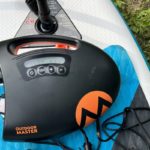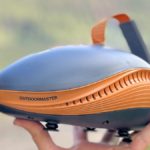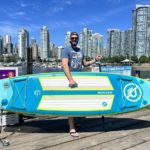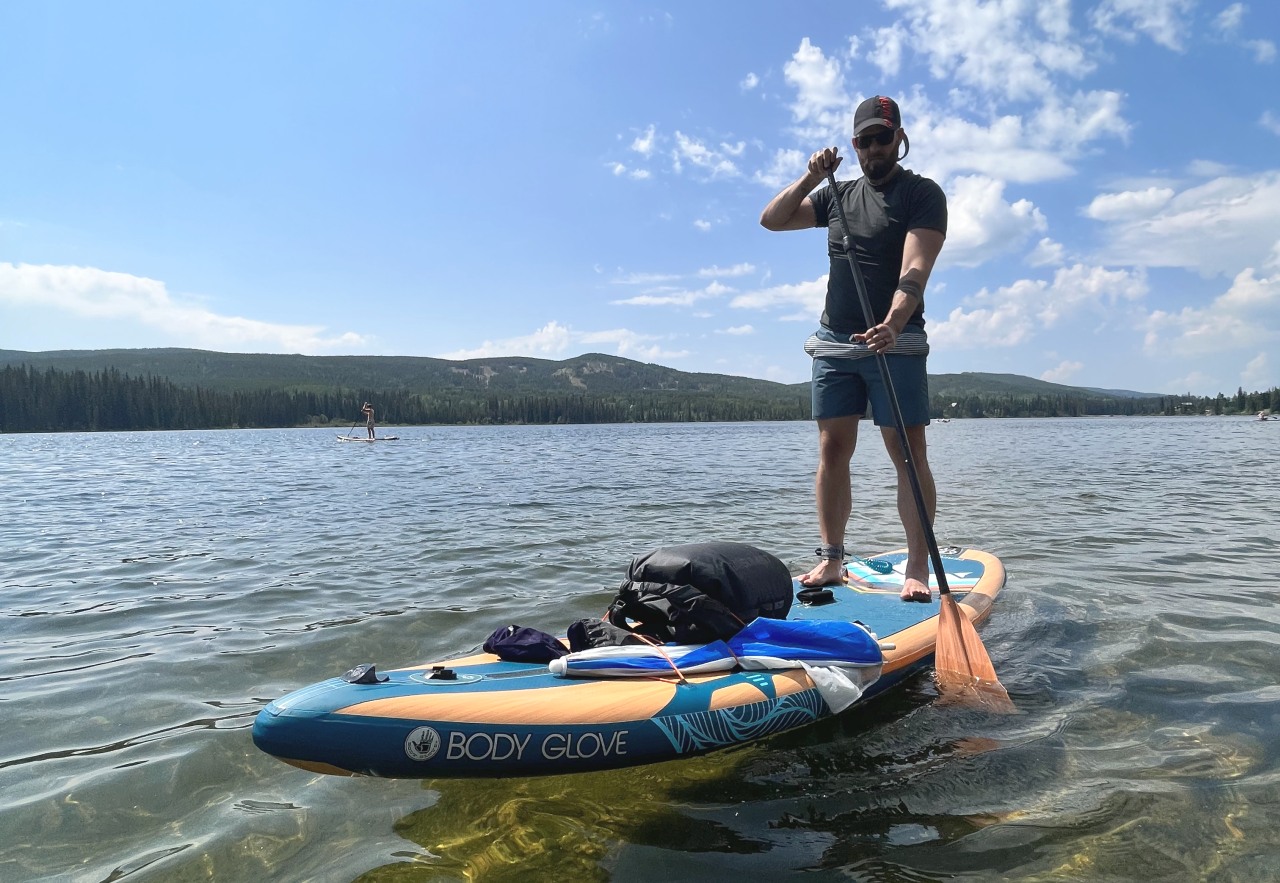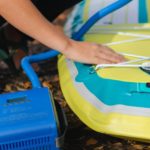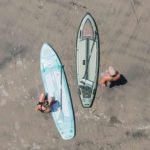OutdoorMaster Shark II is a truly reliable, hard-working, long-lasting pump. Here is our detailed review of this quick, easy, and highly efficient machine.
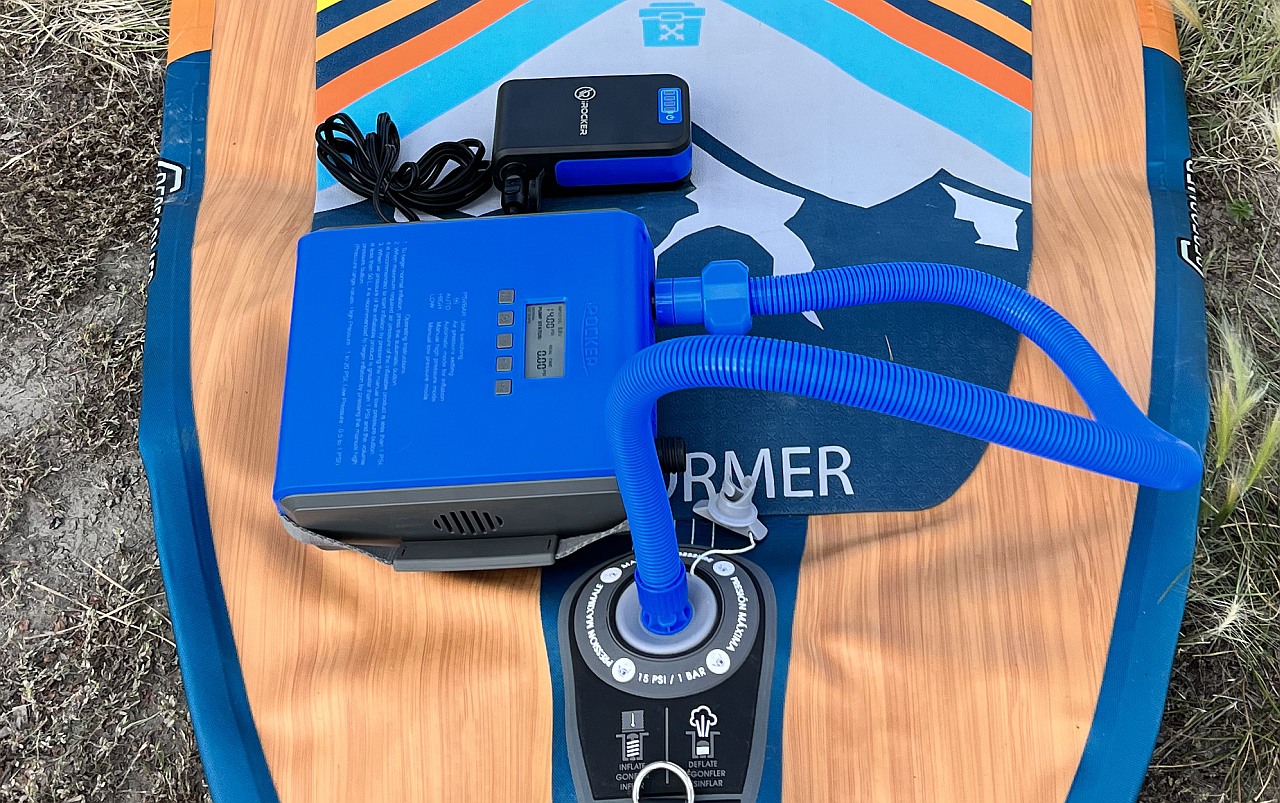
Summer in Canada is all about spending every free moment you can steal away from work and chores on the water.
Really, you only get about 2-3 months of prime paddling time before the weather turns and the temperature drops too low to spend much time paddle boarding.
To that end, I’ve been buying electric SUP pumps so I can get my boards inflated as quickly as possible and with the least amount of effort.
In my research of the best electric SUP pumps, I came across a lot of positive reviews about the iRocker Electric Pump, and I knew it was one I had to get my hands on to test.
I put the pump through its paces, and below, I’ll share with you a complete review of my hands-on testing.
As you’ll see, it has turned out to be one of the best-performing, most efficient, and most portable of all the electric SUP pumps I’ve tested to date. Plus, it’s surprisingly affordable!
Let’s dive right in and find out exactly what makes the iRocker Electric Pump a SUP pump worth considering…

As an affiliate of Amazon and other retailers, we may earn a small commission when you buy via our links, at no additional cost to you. Thank you!
What You Need to Know
| Inflation Speed: | Around 12 minutes to inflate an average-sized SUP. |
| Display: | LCD Digital Display |
| Max PSI: | 20 PSI |
| Power Source: | 12V DC connector plus alligator clips (to connect directly to a car battery) |
| Warranty: | 1 year |
| Decibels: | Around 80 db |
| Safety Features: | Auto shutoff |
Technical Specifications
| Weight: | 3.8 pounds (1,72 kg) |
| Size: | 10 x 7.5 x 4 inches (25,4 x 19 x 10,1 cm) |
| Nozzles: | HR/H3 |
| Max Energy Consumption: | 10A, 120W (12V), DC |
| Pumping Speed: | Unspecified |
| Power Cord Length: | 9 ft (2.75 m) |
| Hose Length: | 4 ft (1.22 m) |
| Supported Pressure Range: | 0.5-20 PSI (0.034-1.378 Bar) |
| Digital Sensor Accuracy: | 0.01 PSI |
What’s in the Package?
One of the things I loved about the iRocker Electric Pump is that it comes packed in a “accessory bag”. This bag serves three purposes:
- It keeps all the small items neatly packed. No losing the hose or nozzles or alligator clips; they all stay together, always accessible. (Plus, the accessory bag includes a handy outside pocket where I store the two fins for my iRocker Cruiser Ultra SUP.)
- It’s waterproof, so it’ll protect the electric pump in a rainstorm or if I’m using it near the water.
- It fits inside the SUP bag (in this case, my iRocker Cruiser Ultra backpack), so I don’t need to carry it separately (like I have to do with, for example, the very bulky OutdoorMaster Shark II).

When you open it up, you can see at a glance exactly what’s inside: the electric SUP pump, the pretty standard 4’ hose, and a bag with a pair of alligator clips.
The alligator clips are a nifty inclusion, one I have yet to see in any other SUP pump I’ve tested or used. It allows me to connect the pump directly to my car’s battery (or some other 12V battery) rather than plugging it into the 12V plug inside the car.
Some older-model cars don’t have 12V plugs easily accessible, or after years of use, the plug stops working properly (it happened to my 2008 Honda Pilot). Having this backup means of connecting the pump to the power source is a big “pro”.
But if you’ll notice, there’s a pretty significant “con” with the iRocker Electric Pump: it only comes with the Halkey-Roberts/H3 nozzle connected.
While every other SUP pump I’ve tested features a selection of nozzles, iRocker’s pump has only the one needed to inflate paddleboards. That means I can’t use it to inflate or deflate anything else I take camping or paddling with me: floating island, pool toys, air mattress, sleeping pads, etc.
It’s definitely not a deal-breaker—it is built for use specifically with paddleboards—but it makes it a less versatile piece of equipment than other SUP pumps.
Plugging It In
If you look at the pictures of the pump above, you’ll see there’s no dangling cord. That’s because iRocker included this genius design feature:

Yes, it’s got a hidden compartment on the side of the pump to store the cord out of the way!
Every other SUP pump I’ve tested either just leaves the cord dangling (which can be a pain when trying to connect hoses and cords and untangle guy lines) or uses a separate cord that can get lost or break.
But the iRocker solves the annoyance easily by using this compartment where you can tuck the cord away, no hassle, no risk of losing it!
And as you’ll see by this picture below, the door to the compartment features a little slot where the cable fits so you can close the door while the cable is connected to your power source.

Such a simple design feature, but it streamlines the entire process so efficiently!
As you saw in the picture above, I chose to connect the power cable not to my car’s 12V plug or the battery directly. Instead, I used iRocker’s Portable Battery.
All summer, I’ve been using GoSun’s 266wh Portable Solar Power Bank as a battery to make it easy to pump up my SUPs lake-side without needing to connect it to my car. iRocker’s Portable Battery can’t quite compare performance-wise—it only has juice enough to inflate 2½ paddleboards, give or take—but it’s significantly cheaper and can be purchased along with the iRocker Electric Pump (sold separately).
But as you can see in the image above, the iRocker Portable Battery comes with a 12V port that lets you plug in the SUP pump’s cable directly. And just like that, you’re ready to power it up and get pumping!
Carrying It Around
As I mentioned above, the pump comes in that handy waterproof “accessory bag”, which fits the pump, the hose, alligator clips, and the battery inside, with the extra Velcro-closed storage pocket on the outside. The whole bag fits inside the iRocker backpacks—one less thing for you to worry about loading and unloading from your car.
For portability’s sake, you also have a nifty handle incorporated into the side of the pump:

The handle is made of tough nylon and has a rubber grip that was wonderfully easy to hang onto, even when my hands were wet.
(Though, as you see in the picture, it’s a good idea to close the cable compartment door before carrying it!)
Inflation Speed
Now we get to the real part of the test, the part I (and most people, probably) care more about: how fast will the pump inflate your SUPs?
To begin, I connected it to my iRocker Cruiser Ultra, a 10’6” by 33 x 6” board with a fill volume of around 322 liters. It’s the smaller of the two boards I wanted to test, so an easy starting point.

I’ve been setting my SUP to a slightly lower PSI than before—rather than the 15 PSI I’ve been using for the last few months, I now set to 14 PSI. Should be a faster fill, right?
Setting the pump to my desired PSI, I hit the “Auto” button and let it get filling.
Like most electric SUP pumps, the iRocker Electric Pump operates in two stages:
- Stage 1: A high-volume, low-pressure stage. This is intended to fill the empty board as quickly as possible and bring it up to low pressure (typically under 1 PSI).
- Stage 2: A low-volume, high-pressure stage. This is intended to fill the already full board even more, which requires the pump to force air in at ever-increasing pressure.
I was incredibly surprised that Stage 1 took around 90 seconds:

Typically, it’s closer to 2+ minutes for the average SUP pump to fill it with enough air that the pressure begins to rise and the pump needs to switch to Stage 2. What this means is that the air flow in Stage 1 is likely higher than the “average”, typically around 350L/min.
(Unfortunately, iRocker doesn’t have that particular data available anywhere on its website, so I can’t tell you exactly what the output is on either Stage 1 or Stage 2.)
Once the pump switched over to Stage 2, it got a bit noisier (see the “How Noisy Is it?” section below). I sat back and waited for it to finish pumping up.
But I didn’t have to wait for long!
Almost before I realized it, the pressure was hitting the 11, 12, and 13 PSI mark. When finally it hit 14 PSI and shut off, only 12 minutes and 30 seconds had passed.

Impressive, right? The only other pump I’ve tested with the same inflation speed is the hefty OutdoorMaster Shark II.
To confirm that data, I hooked it up to another board—this one an 11” BodyGlove Performer—and let it get to work.

Again, it reached the end of the high-volume, low-pressure Stage 1 in around 90 seconds:

And even though this SUP is 6 inches longer and 1 inch wider, it actually filled up faster than the iRocker Cruiser Ultra.

Yes, just over 12 minutes. Pretty impressive inflation speed, all things considered. In this last test, it actually proved faster than the OutdoorMaster Shark II, making it the fastest SUP pump I’ve tested to date.
Important Safety Features
In all of my research into the iRocker Electric Pump, I couldn’t find any specific information on any cooling features or any design components that prevent it overheating.
However, after inflating the two boards back to back, I felt no abnormal amounts of heat radiating from the pump, and couldn’t detect any smell of burning plastic or overheating metal.
I wouldn’t hesitate to use it to inflate three SUPs, or run it until the iRocker Portable Battery runs out of power. But with a few minutes to rest and cool down, I’d feel comfortable hooking it up to a new power source and running it a while longer.
The pump does come with an integrated 10A fuse that will protect it from electrical surges, and protect the car it’s connected to from being damaged as well.
How High Can It Go?
Like most of the electric SUP pumps I’ve tested, the iRocker Electric Pump can go all the way up to 20 PSI. It’s also capable of filling as little as 0.5 PSI using the “auto” setting.
One very cool feature about this pump is that you can manually switch it to either Stage 1 and Stage 2 using the High and Low buttons.

The High button will switch it to the high-pressure, low-volume mode, so you can easily top up a paddleboard that has deflated.
The Low button will switch it to the low-pressure, high-volume mode, which is better for inflating pool toys, air mattresses, and other inflatables.
Controlling the PSI/Bar setting is a bit of a hassle. iRocker’s pump doesn’t have a “+” and “-“ button like so many other pumps have that let you raise and lower the pressure at will. Instead, the “+” button raises the pressure all the way to 20 PSI, then starts again from 0.5 PSI.
When I wanted to change the settings from my standard 14 PSI to the 12 PSI my wife prefers, I had to cycle all the way to 20 PSI, then back again from 0.5 to 12.
Save Time With the Auto Shut-Off
This is one of my all-time favorite features of any electric SUP pump, and I’m always glad to see it included. The iRocker is no exception: it does include an auto shut-off feature.
All I have to do is program the pump to my desired PSI, hit the “Auto” button to get it started, and it’ll run merrily on its own. When it hits the target PSI (as shown on the digital display), it automatically shuts off. No risk of overfilling the board, just safe, efficient operation.
This means that while it’s doing its thing, I can finish unloading my car, making camp, unpacking the next paddle board, or loading up my dry bag to hit the water. It’s a wonderfully convenient feature that I absolutely adore.
How Noisy is It?
iRocker’s website doesn’t provide exact specifications on the noise volume. However, the good folks over at Inflatable Boarder ran a test of the pump and found that it operated at around 82 db on the high-pressure, low-volume, ultra-noisy Stage 2.
According to data collected by Purdue University, that’s around the same as:
- A garbage disposal unit (80 db)
- A diesel truck going 40 MPH at 50 feet (84 db)
- A milling machine (85 db)
Long-term, it’s loud enough to cause hearing damage, but really, you’re only running the pump for 10 to 30 minutes per outing, so it’s nothing to worry about.
Deflation and Packing
One of the things I loved about this pump is that it comes with a deflation setting.

Most of the SUPs I’ve tested to date are fairly easy to deflate after use: just push down the nozzle to let out most of the air, then compress it as you roll it up to keep pushing out all the air.
But when I tested out the BodyGlove Performer 11, I found that the “best” way to roll it up wasn’t from nose to tail like I typically did, but starting at the tail (due to the built-in fins). What that meant was that if the SUP wasn’t fully deflated before I began to pack it up, it’d still be full of air by the time I rolled it up to the nose.
Because of that, I’ve had to use an electric pump to deflate that particular SUP before folding it up.

Thanks to the deflate setting on the iRocker pump, I could get to work rolling up my other SUP while the pump was sucking all the air out of the BodyGlove Performer 11. Then, once it was fully drained of air, it was easy to roll it up and pack it away.
And, of course, when I’m done with the pump, I just disconnect it from the hose, tuck the cable away into its nifty storage compartment, put it in the accessory bag, and store the bag in the iRocker Cruiser Ultra backpack. Easy as pie!
Warranty
iRocker backs its pump up with a 1-year warranty (unlike its iRocker and Blackfin boards, which have a 2-year warranty).
Given that I plan to paddle for many more years to come, I do wish the warranty was a bit longer—that would inspire more confidence that iRocker built this pump to last for more than 1-2 paddling seasons.
It feels like a sturdy, solid, well-built pump that should serve me well for years. But only time and frequent use will tell for sure.
How Does It Compare to Other SUP Pumps?
| iRocker Electric Pump | OutdoorMaster Dolphin II | OutdoorMaster Shark II | BodyGlove Electric Pump | |
|---|---|---|---|---|
| Weight: | 3.8 lbs. (1,72 kg) | 2.93 lbs. (1.27 kg) | 3.6 lbs. (1.63 kg) | 2.6 lbs. (1,18 kg) |
| Size: | 10 x 7.5 x 4 inches inches (25,4 x 19 x 10,1 cm) | 10.31 x 6.89 x 6.46 inches (25.9 x 17 x 16.7 cm) | 12.48 x 10.55 x 7.24 inches (31.7 x 26.8 x 18.4 cm) | 10 x 6.5 x 6 inches (25,4 x 16,5 x 15,2 cm) |
| Power Source: | 12V DC, alligator clips | 12V DC | 12V DC | 12V DC |
| Pumping Speed: | Unspecified | 40/L min | 350L/Min At 1st Stage70L/Min At 2nd Stage | Unspecified |
| Dual Inflators Switch Point: | 0.75-0.9 PSI (0.05-0.06 Bar) | N/A | 1 PSI (0.07 Bar) | ~1 PSI (0.07 Bar) |
| Supported Pressure Range: | 0.5-20 PSI (0.034-1.378 Bar) | 0.5-20 PSI (0.034-1.378 Bar) | 0.5-20 PSI (0.034-1.378 Bar) | 0.5-16 PSI (0.034-1.103 Bar) |
| Notable Features: | Comes packed in its own waterproof “accessory bag” and fits into iRocker SUP backpacks | Compact enough to fit in SUP backpacks | Pump up to 3 boards without stopping | Fits inside the rolled-up BodyGlove SUPs |
| Price: | $59.00 | $59.99 | $103.89 | $89.00 |
My Conclusions
After testing iRocker’s Electric SUP Pump, it’s safe to say that it’s one of my new favorite go-to’s for my paddle board trips.
The fact that it comes packed in its own accessory bag inside the iRocker Cruiser Ultra backpack is a huge “win”, because it means I can carry it everywhere I take the SUP. Plus, the bag is spacious enough to house the pump, hose, an iRocker Battery, and other accessories (like the SUP’s fins). And who can say no to extra storage space?
Other things that I like about it include the hidden cord storage, the fast fill speed (faster even than the OutdoorMaster Shark II), the ability to manually set it to Stage 1 or Stage 2, the deflate setting for easy packing, and the comfortable carrying handle.
Sure it’s got a few drawbacks—it only has the HR nozzle so I can’t use it for anything else other than inflating SUPs, the noise level is higher-than-average, and there’s no extra cooling technology to keep it from overheating—but after putting it to the test, I’ve concluded that it’s one of the most reliable of the electric SUP pumps on the market. Absolutely worth the bargain-friendly price tag, too!

